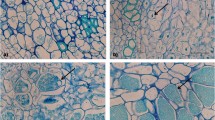Abstract
The survival ofCorynebacterium sepedonicum, the bacterial ring rot pathogen, in infected potato stems and on burlap surfaces held at various freezing and above-freezing temperatures was investigated by root-inoculating potato stem cuttings with aqueous suspensions prepared from these materials. Infectious bacteria were recovered from dried Russet Burbank stems held for 44 mo in an unheated machine shed and from dried Warba stems held for 55 mo. Inoculum from dried stems of all cultivars held for 63 mo did not incite symptoms; however, inoculum from Russet Burbank stems incited symptomless infection in 10% of the inoculated plants. This 63-mo survival period exceeds a 26-mo survival period previously reported.
Ring rot bacteria survived and remained infectious for at least 18 mo on burlap surfaces subjected to temperatures of −40° to −5°C, alternating temperatures of -5° to 5°C, or a constant temperature of 5°C. Inoculum from burlap stored at the lower temperatures caused the most severe symptoms. These results stress the need for keeping crop debris away from potato operations and for using proper decontamination procedures to maintain potato seed stocks free of ring rot.
Resumen
La sobrevivencia deCorynebacterium sepedonicum, el patógeno de la pudrición anular, fué investigada en tallos infectados de papa y superficies de harpillera mantenidos a varias temperaturas de congelamiento y superiores. La sobrevivencia fué determinada mediante la inoculatión de raices de esquejes de papa con suspensiones en agua preparadas a partir de estos materiales. Se recuperaron bacterias infecciosas de tallos secos de Russet Burbank mantenidos 44 meses en un galpón de maquinaria sin calefacción y de tallos secos de Warba guardados 55 meses. Preparaciones de tallos secos de todos los cultivares guardados por 63 meses no produjeron sintomas; sin embargo, inóculo de tallos de Russet Burbank indujeron infectión latente en 10% de las plantas inoculadas. Este período de sobrevivencia de 63 meses excede al periodo de 26 meses previamente publicado.
La bacteria de la pudrición anular sobrevivió y se mantuvo infecciosa por lo menos 18 meses en harpillera sometida a temperaturas de -40 a-5°C, temperaturas alternantes de -5 a 5°C, o constante a 5°C. El inóculo preparado de harpillera guardada a las temperaturas mas bajas produjo los síntomas mas severos. Estos resultados enfatizan la necesidad de mantener los rastrojos de papa alejados del manipuleo de la papa y de usar procedimientos de decontaminación apropiados para mantener los núcleos de semilla libres de la pudrición anular.
Similar content being viewed by others
Literature Cited
Haasis, F.W. 1940. The distribution ofPhytomonas sepedonica in potato seed pieces, plants, and tubers, and its significance. Calif Dep Agric Month Bull 29:16–20.
Kreutzer, W.A. and J.G. McLean. 1943. Location and movement of the causal agent of ring rot in the potato plant. Colo Agric Exp Stn Tech Bull 30.
Lelliott, R.A. and P.W. Sellar. 1976. The detection of latent ring rot (Corynebacterium sepedonicum [Spieck. et Kotth.] Skapt. et Burkh.) in potato stocks. Bull Organ Eur Mediterr Prot Plant 6:101–106.
Nelson, G.A. 1978. Survival ofCorynebacterium sepedonicum on contaminated surfaces. Am Potato J 55:449–452.
Nelson, G.A. 1979. Persistence ofCorynebacterium sepedonicum in soil and in buried potato stems. Am Potato J 56:71–77.
Nelson, G.A. 1980. Long-term survival ofCorynebacterium sepedonicum on contaminated surfaces and in infected potato stems. Am Potato J 57:595–600.
Nelson, G.A. 1982.Corynebacterium sepedonicum in potato: Effect of inoculum concentration on ring rot symptoms and latent infection. Can J Plant Pathol 4:129–133.
Nelson, G.A. and G.C. Kozub. 1983. Effect of total light energy on symptoms and growth of ring rot-infected Red Pontiac potato plants. Am Potato J 60:461–468.
Nelson, G.A. and G. Semeniuk. 1964. An antagonistic variant ofCorynebacterium insidiosum and some properties of the inhibitor. Phytopathology 54:330–335.
Nelson, G.A. and W.E. Torfason. 1974. Associative effects of leaf roll and ring rot on disease expression and yield of potatoes. Am Potato J 51:12–15.
Nelson, G.A., W.E. Torfason and F.R. Harper. 1971. Comparison of inoculation methods on ring rot development in potatoes. Am Potato J 48:225–229.
Perkins, Barbara L. and G.H. Starr. 1949. The prevalence and distribution ofCorynebacterium sepedonicum in potato plants. Colo-Wyo Acad Sci J 4:50 (Abstr.)
Raeder, J.M. 1945. Spread of bacterial ring rot can be prevented. Idaho Agric Exp Stn Ann Rep 52:31–32.
Author information
Authors and Affiliations
Rights and permissions
About this article
Cite this article
Nelson, G.A. Survival ofCorynebacterium sepedonicum in potato stems and on surfaces held at freezing and above-freezing temperatures. American Potato Journal 62, 23–28 (1985). https://doi.org/10.1007/BF02871296
Accepted:
Issue Date:
DOI: https://doi.org/10.1007/BF02871296




